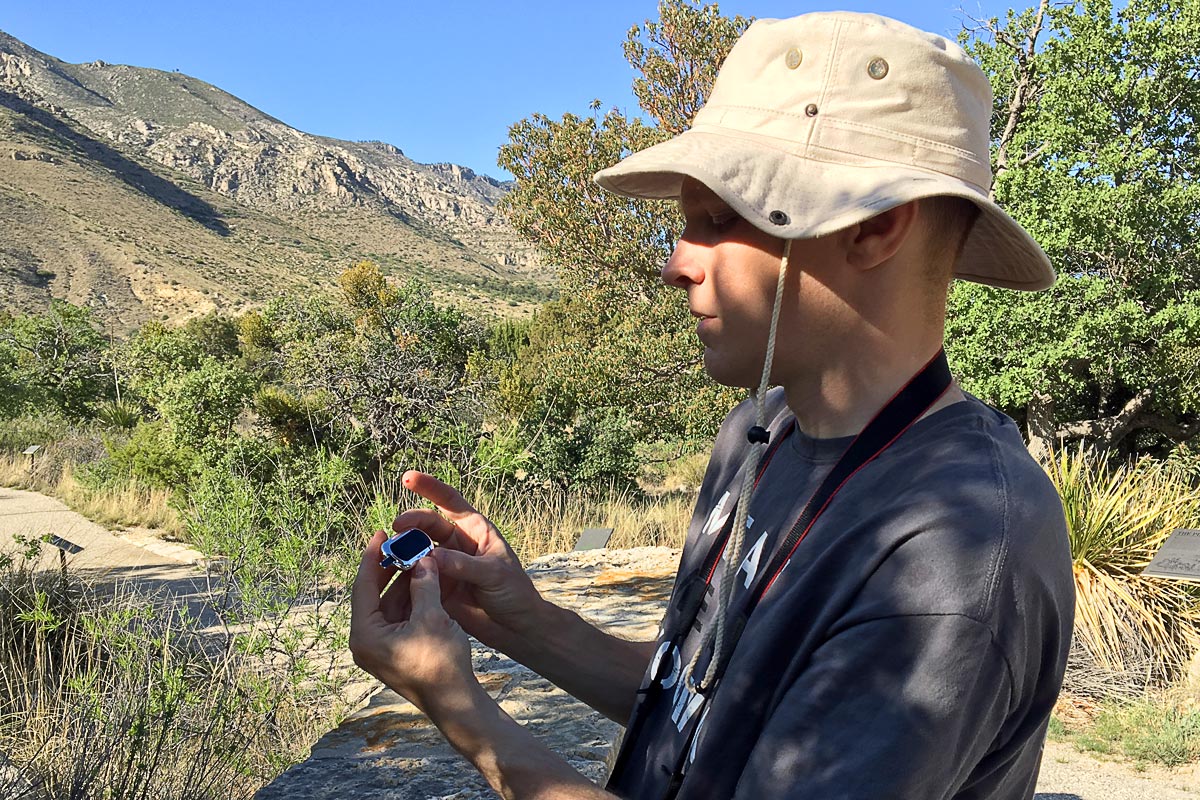
When did you get up today?
You never used to sleep so late
Never mind, it's always 3:00 am
—Guadalcanal Diary
High, rocky, full of dramatic dips, cavernous canyons, and steep, misshapen peaks: Guadalupe Mountains National Park extends over part of its namesake mountain range in far western Texas offering visitors some surprising greenery, abundant wildlife, fascinating hiking opportunities, and one of the best night skies I’ve ever seen up close and personal.
Having been under the mountains two days ago to see Carlsbad Caverns National Park, Masayo and I made it to Guadalupe Mountains NP, just down the road, in time to secure a campsite and to find a place for a picnic under the peaks.



Guadalupe Mountains doesn’t have much you can see by car: it’s for hikers. But hiking wasn’t in the cards for Masayo and I today. We wanted an easier visit, so we set about to see all we could in our own way.
First we drove to a site called Frijole Ranch which was an ideal spot for a picnic. The Ranch itself is two hundred-year-old buildings situated around a spring that still bubbles forth at 6 gallons a minute. The white building is the charming two-story house, while the small red one served as a schoolhouse. They were closed but the small and lush grounds were open so people could stroll around, listening to the water gurgling and the birds chattering about their good fortune for finding such a place in the Texas desert.
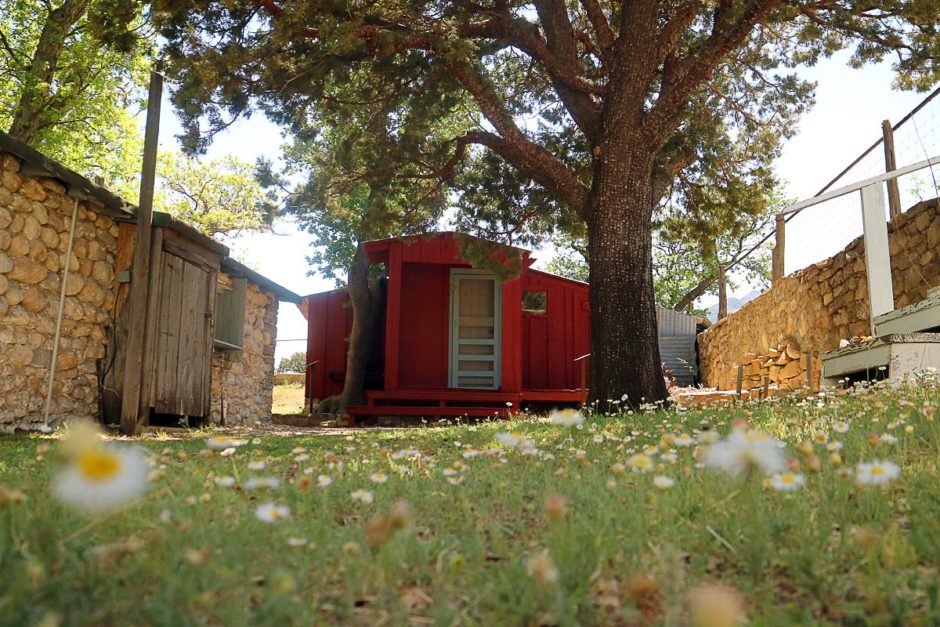
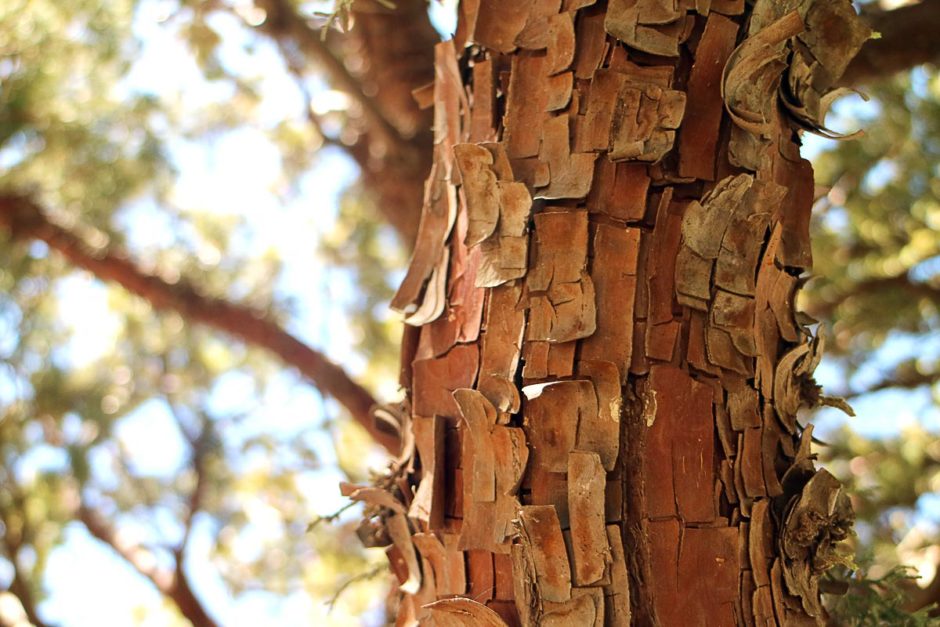
This tree is called alligator juniper thanks to its reptilian bark.

From there, only one other paved road seems to enter into Guadalupe Mountains National Park itself: the one that goes to a place called McKittrick Canyon. There’s a visitor center and several hikes into the fecund canyon.

McKittrick Canyon.

The center was closed but we signed up at the self-paying fee station and took the mile-long “Nature Loop”, a well-marked but surprisingly far-reaching excursion through cactus and many other kinds of plants. Mostly what we saw were insects: grasshoppers bounding from rock to rock, flatbugs hanging out at the top of giant asparagus plants (actually New Mexico agave), and bees and flies hovering around our ears the whole way, buzzing away with incessant inquisitiveness.
No rattlesnakes, luckily. And believe me, I was listening.

After this rather unexpected excursion we headed back to the camp for dinner. It was early, but we had a date with the sunset at 7:00 pm and didn’t want to keep it waiting.

Besides Texas’ highest point, Guadalupe Mountain itself, the other main attraction in the Park is giant El Capitan, a highly distinctive peak that rises suddenly from its surroundings up long vertical surfaces. It has long acted as a way for locals to get their bearings, and a ranger had told us that we should go to a certain picnic area on Highway 62 to see it illuminated in orange when the sun went down.
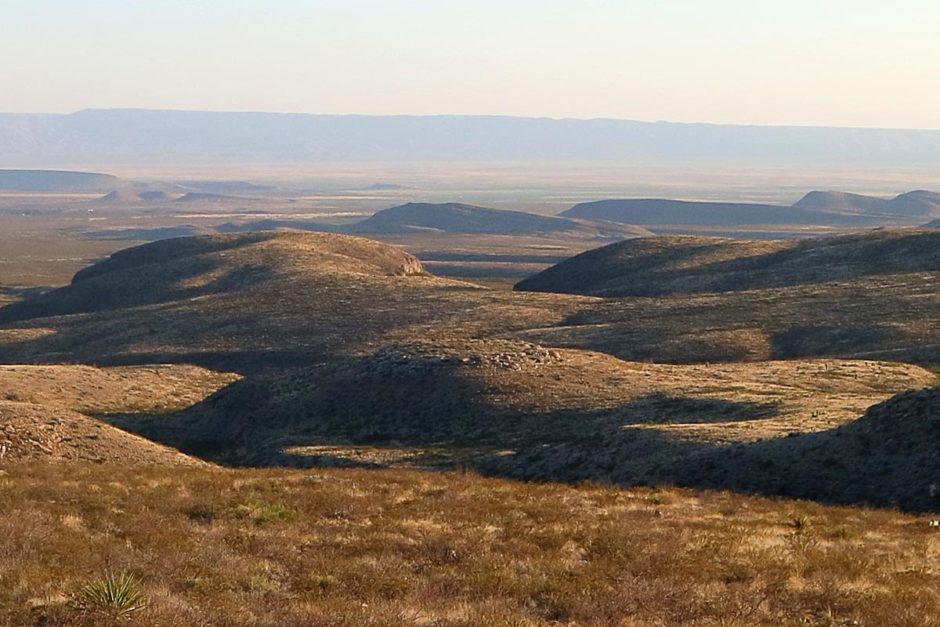
The day was so clear that there was no especially amazing sunset, though the orange highlights on El Capitan did make the trip worth it. All I could think was, “Tonight’s entertainment is not watching TV or wasting hours online, it’s standing beside an almost carless road in the cool evening air waiting to see the sunset on a large rock in rural Texas. Funny what a different travel makes in ones daily life.”

Sunset on El Capitan.
Thus entertained, we headed back to the campsite for what I’d really been anticipating: stars in the night sky.
As a city-dweller just like you, I know that stars exist but I rarely get to see many of them. Guadalupe Mountains takes care of that for you. That clear sky that made the sunset merely awesome now revealed an endless pattern of little white dots, all around us. Hunter’s Peak and Guadalupe Peak, which formed the walls of our campsite, were both now solid black shapes, defined by the merrily twinkling stars that filled their negative space.


I whirled my camera around on its tripod, adjusting settings manically and trying to capture what I saw. And while I got some nice images, I must stress that being there is different. Hearing the quiet of the hillsides broken only by the middle-aged physicists laughing nerdily a couple campsites over, repeatedly mistaking airplanes for shooting stars for a split second, trying not to trip over your tent wires, camp soup sloshing around in your belly… the experience of being there can’t be captured in any photograph.
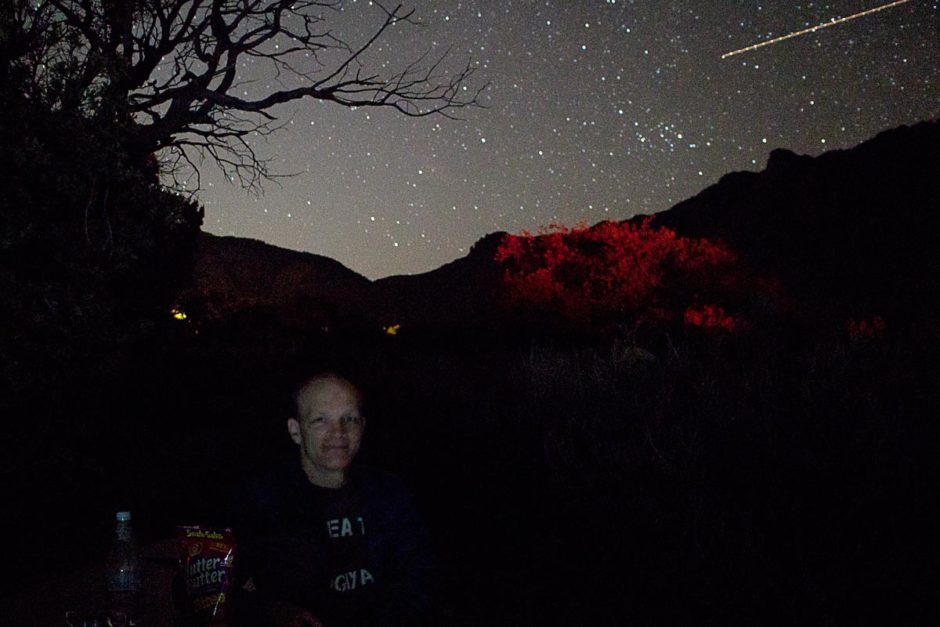
Night passed easily; this is only our second night of tent camping on this trip and I slept better. For one thing, we figured out how to make the tent not sag in the middle. Plus, I used a soft jacket for a pillow.
But it wasn’t a night of long, unbroken sleep for me. I kept waking up and, through the thin mesh of the tent, seeing the very bright and distinctive Big Dipper right in front of my eyes. Every time I did, it had rotated a few degrees in the sky, and I marked its progress as I struggled to calm myself down and sleep again. Eventually, the sliver moon came out and soon after it, the dawn. I gave up, got out of the tent while Masayo slept on, and set up my camera for some morning shots while I boiled water for coffee.

Trees against the morning sky.
The sunrise turned out to be even better than the sunset: the skies were again crystal clear and thus filled with merely-awesome if not life-alteringly stunning faded solid colors. But the way the sun illuminated Guadalupe Mountain in an aggressive but soft orange – and only that mountain, leaving the others colder and greyer – was almost literally unbelievable.
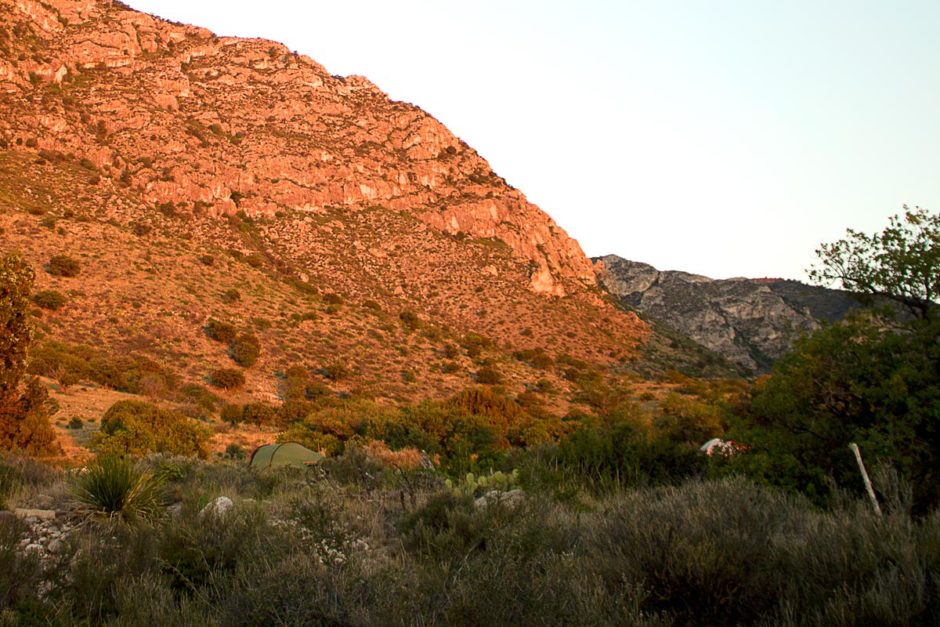
Guadalupe Mountain was bright orange for about three minutes.
How did the sun know to light up that one mountain? The sun knows the names we give to Parks?? It seemed so at 6:00 am in Guadalupe Mountains National Park.
After breakfast (oatmeal plus crepes made of tortillas and prickly pear cactus jelly from the gift shop) we packed everything up and said our goodbyes to the visitor center one more time. Guadalupe Mountains was subtle in its effect, a land of riches that best reveal themselves to those who take the time and put in the effort to allow them to be shown on their own time.
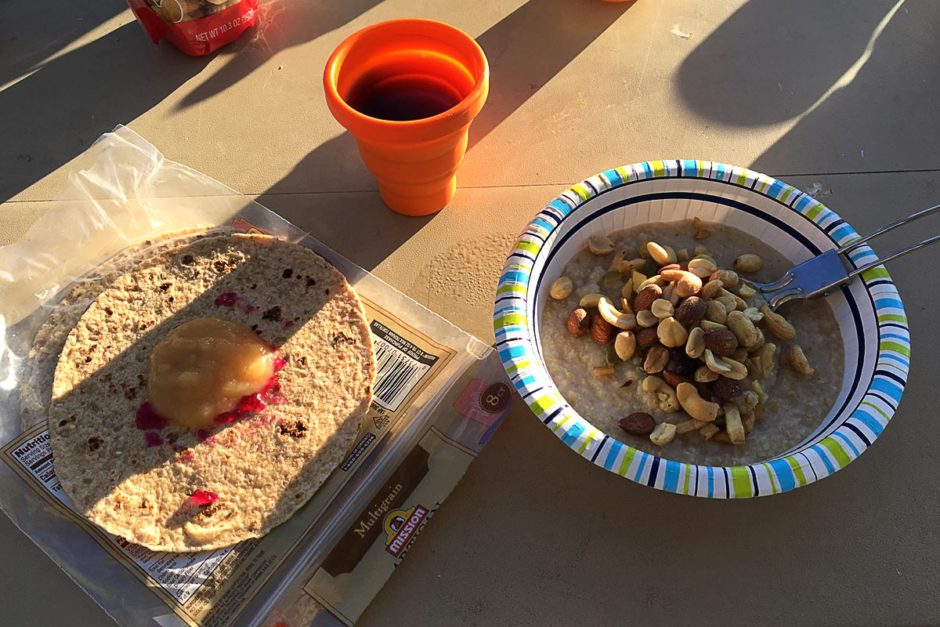

And yesterday was laundry day…
Guadalupe Mountains fixed my blood sugar
My reading before breakfast in the motel in Roswell, NM was 319. Fast food the night before and day of zero activity had worked their foul magic on me. I took a bunch of insulin, had free cereal in the lobby, and Masayo and I set out for Guadalupe Mountains NP.
By the time we arrived, I’d grunted and sweated pounding tent stakes in the ground, and it was lunch time, I was 135. Excellent. And the Park made sure I stayed excellent, despite an unusual day of food, exercise, and excitement.

Before dinner, after the spur-of-the-moment nature hike, I was 99. After dinner and driving to catch the sunset on El Capitan, I was 74 and had a couple cookies. In the middle of the night, I got curious and checked: 104. By the time the sunrise had pulled me out of the tent, I was 156.
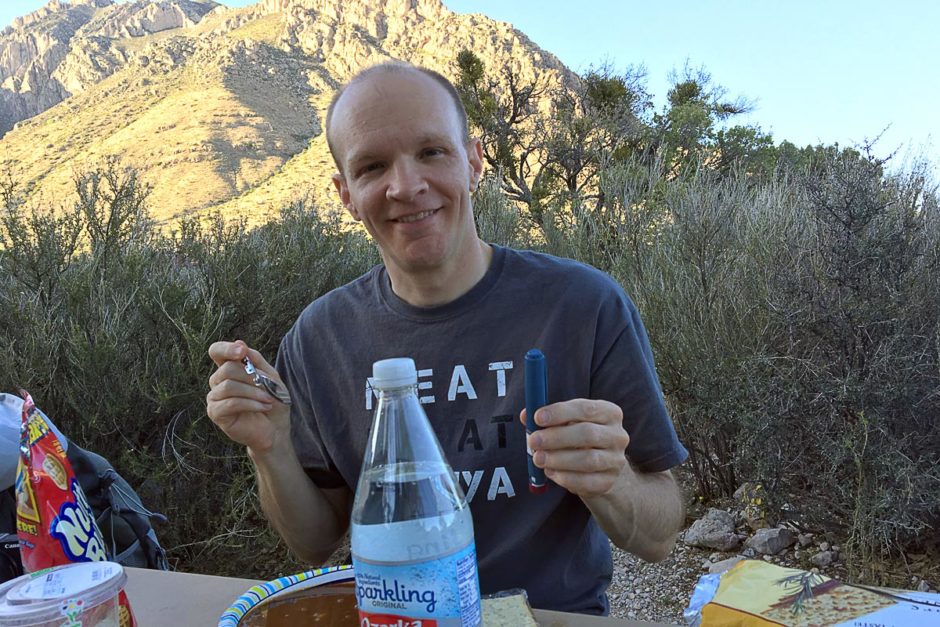
You can’t ask for a much better run than that, especially when you also get a series of deliriously fascinating skies to stare in wonder at. I have noticed that, broadly speaking, National Parks inspire activity and activity makes diabetes behave. Now that’s a relationship I can get behind!
Thanks for reading. Suggested:
- Share:
- Read next: Day 18: Winds blow BG higher in Big Bend National Park
- News: Newsletter (posted for free on Patreon every week)
- Support: Patreon (watch extended, ad-free videos and get other perks)

Support independent travel content
You can support my work via Patreon. Get early links to new videos, shout-outs in my videos, and other perks for as little as $1/month.
Your support helps me make more videos and bring you travels from interesting and lesser-known places. Join us! See details, perks, and support tiers at patreon.com/t1dwanderer. Thanks!
